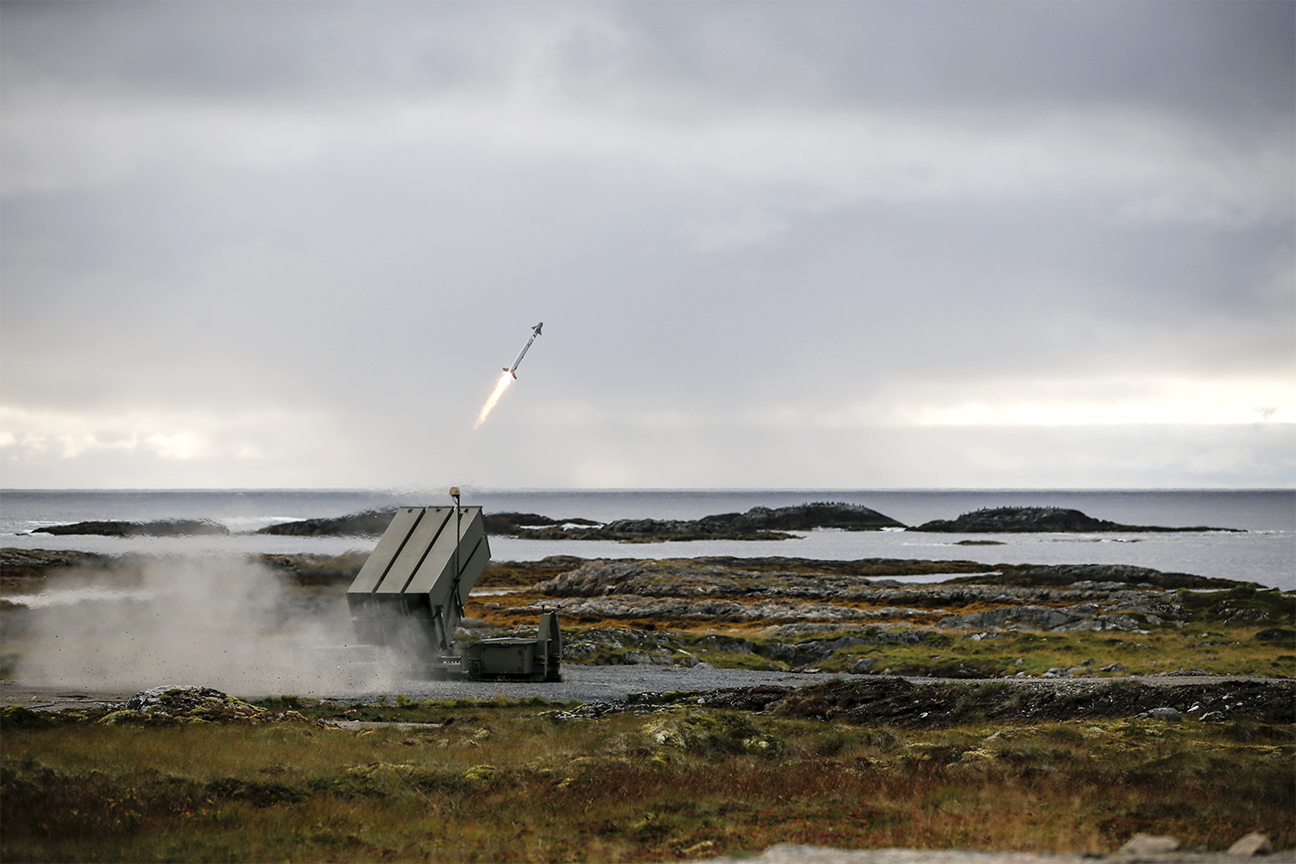WRIGHT-PATTERSON AIR FORCE BASE, Ohio (AFRL) – Industry contractors on two Air Force Research Laboratory, or AFRL, Integrated Capabilities Directorate projects have been named as finalists in the Aviation Week Network’s 2023 Program Excellence Awards.

The concept of adapting multiple base defense weapon types for use in National Advanced Surface-to-Air Missile System, or NASAMS, launchers was tested at the Trident Elding 2022 exercise in Norway. Raytheon is a finalist in Aviation Week Network’s 2023 Program Excellence Awards Special Projects category because of its role in Trident Elding 2022. (U.S. Air Force photo)
Lockheed Martin’s efforts involving the Integrated Capabilities Directorate’s Rapid Dragon Palletized Effects Experimentation Campaign and Raytheon’s work on the Strategic Development Planning and Experimentation, or SDPE, Air Base Air Defense Experiment are finalists in Aviation Week’s Special Projects category.
They are among 18 finalists in seven categories. The finalists will be honored, and the winners will be named, Nov. 8 at the annual Program Excellence Dinner and Awards Ceremony in Washington, D.C.
The Program Excellence Awards categories include Original Equipment Manufacturer, or OEM, System Design and Development; OEM System Production; OEM System Sustainment; Special Projects; Supplier System Design and Development; Supplier System Production; and Supplier System Sustainment.
Rapid Dragon is a palletized munitions experimentation campaign exploring the feasibility and operational advantages of airdropping long-range palletized munitions from unmodified existing airlift platforms, such as the C-130 and C-17.
Rapid Dragon weapons pallets are released from cargo planes before weapons are dropped and flown to intended targets. If necessary, the weapons can be assigned different targets while in flight.
Rapid Dragon went from concept in 2021 to conducting its first live-fire test 2022. In the fall of 2022, the Integrated Capabilities Directorate’s SDPE office partnered in a total-force initiative to conduct the first live-fire demonstration of Rapid Dragon in the U.S.-European Command theater.

Rapid Dragon is a palletized munitions experimentation campaign exploring the feasibility and operational advantages of airdropping long-range palletized munitions from unmodified existing airlift platforms, such as the C-130 and C-17. In this photo from a test in November 2021, a cruise missile is released from a pallet and deploys its wings and tail. Lockheed Martin’s Rapid Dragon efforts have made the company a finalist in Aviation Week Network’s 2023 Program Excellence Awards Special Projects category. (Courtesy photo)
Rapid Dragon also is expanding to include kinetic and non-kinetic effects; intelligence, surveillance, and reconnaissance platforms; cargo resupply; and humanitarian assistance and disaster relief.
Lockheed Martin’s award application cited the multiple technological and operational firsts for the Department of Defense, U.S. Air Force and foreign partners.
“The Rapid Dragon program has become an exemplar for successful rapid prototyping and experimentation – delivering on-budget performance on a fast-tracked schedule,” Dr. Deanelle Hidalgo and Dr. Dean Evans, project managers, wrote in their application. “This type of experimentation campaign, that address(es) capability gaps and demonstrates transformative efforts, helps us shape future requirements and reduces timeline to fielding. This approach ultimately enables a rapid fielding alternative to traditional lengthy acquisition times.”
In the application, Lockheed Martin said it partnered with AFRL SDPE to build a development team of government airdrop, mobility and special operations subject matter experts; a Navy Battle Management Command and Control System team; test range and safety organizations; and operational/development test leads.
USAF Rapid Dragon Program Manager Dr. Dean Evans attributed the program’s success to its “learning culture, collaborative environment and transition-focused mentality.”
“Rapid Dragon was able to accelerate development by building a broad and strong team,” Evans wrote in the application. “We were committed to a ‘test often, learn-fast’ culture, dedicated to experimenting frequently and taking calculated risks. Collaboration from the onset streamlined the process and accelerated development, involving groups from the program inception that are not normally included at the very early stages, and that has made all the difference.”
Raytheon’s SDPE Air Base Air Defense Experiment award application described its role in the Trident Elding 2022 test of the National Advanced Surface-to-Air Missile System, or NASAMS, in Norway. Trident Elding confirmed that multiple base defense weapon variants can be fired from a NASAMS launcher and integrated into Air Force command and control systems.
The application cited the Raytheon-led team designed, integrated, tested and executed the demonstration within nine months.
“We demonstrated how integrated defense solutions enable the warfighter to deploy the right effect or at the right time and at the right target,” said Wes Kremer, president, Raytheon Missiles and Defense. “Using fielded systems, our goal is to provide customers the quickest, most effective way to protect their people and critical infrastructure with layered cruise missile defense.”
Raytheon’s multi-discipline and cross-functional team learned to collaborate with, plan and execute a joint exercise across the Air Force, Army and Navy, the company cited in the application.
About AFRL
The Air Force Research Laboratory, or AFRL, is the primary scientific research and development center for the Department of the Air Force. AFRL plays an integral role in leading the discovery, development, and integration of affordable warfighting technologies for our air, space, and cyberspace force. With a workforce of more than 12,500 across nine technology areas and 40 other operations across the globe, AFRL provides a diverse portfolio of science and technology ranging from fundamental to advanced research and technology development. For more information, visit: www.afresearchlab.com.
